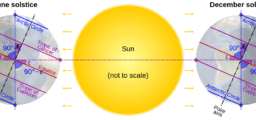Local students view Mercury Transit
This past Monday, local amateur astronomers set up solar filtered telescopes at several schools for students to observe the transit of the planet Mercury across the surface of the Sun. This incredible opportunity allowed students to experience the nature of science by witnessing an event in real time.
Telescopes were set up at Valley High, Kanab High, Kanab Middle, and Kanab Elementary Schools. Members of Stellar Vista Observatory, a local nonprofit organization, set up the telescopes for viewing and took questions from the students.
Enthusiastic students in multiple grades viewed this event over several hours Monday morning. These experiences help students grasp the power of calculated predictions that science can achieve.
There were many surprised comments from the students when they first saw the black dot of Mercury.
The most common was, “It’s so tiny,” perhaps best stated by Valley 10th grader Brittyn Heaton, “It was amazing to see the small scale of Mercury against the Sun!”
Others commented on how astonished they were that the precise time of the event could be determined so far in the future.Special solar filters must be used any time one looks at the Sun, otherwise eye damage can occur. However, even with a proper filter, one would not be able to see the small dot of Mercury on the face of the Sun with just the naked eye. This is why a solar filtered telescope is necessary to view planetary transits.
A transit is similar to an eclipse, except that the celestial body in front appears very small compared to the one in back. During an eclipse the body in front appears close to or larger than the object in back, diminishing or completely blocking the light from it.
The first successful observation of a Mercury transit was made by Pierre Gassendi in 1631. He noted that Mercury appeared as a much smaller shadow on the Sun than expected.
This meant that Earth must be much farther from the Sun than generally thought. It was the first clue to the true scale of the solar system.
In 1677 Edmund Hally and Richard Towneley both observed Mercury’s transit, and made a reasonable measurement of Earth’s distance from the Sun.
This calculation was further refined later, but it was the early observations of Mercury transits that first gave us an understanding of just how big the universe was.
Due to Earth’s position in the solar system, we can only see the solar transits of Mercury and Venus, because their orbits lie inside of Earth’s orbit around the Sun.
On Monday, Mercury took five and a half hours to cross in front of the Sun (5:36 to 11:04 MST). It was a relatively rare event, with the previous occurrence having occurred in May 2016 and next happening on November 13, 2032. In the case of Venus, the last transit was in June 2012 and the next transit will not occur until December 10, 2117.
Stellar Vista Observatory, a local nonprofit, is working toward building and operating a space observatory here in Kanab as a public and educational venue.
The observatory will provide learning experiences to serve youth in primary, secondary and post-secondary education, as well as adults and the visiting public.
Many visitors to our area witness, for the very first time, a clear starry night sky. Clear weather, high altitude and substantial distance from major cities or sources of light pollution make Kanab and Kane County an ideal location for a space observatory.
Stellar Vista Observatory has hosted eight free public star parties with more to come. If you would like to lend your support to the space observatory, please contact us.



